Cationized Hemp Fiber to Improve the Interfacial Adhesion in PLA Composite
Abstract
1. Introduction
2. Materials and Methods
2.1. Materials
2.2. Fiber Grinding
2.3. Fiber Treatment
2.4. Mixin Proportions
2.5. Preparation of the Specimens
2.6. Tensile Test
2.7. SEM and EDS Analyses
3. Results
3.1. Influence of EPTA on Mixtures
3.2. Tensile Strength
3.3. Morphology of the Fractured Surface
4. Conclusions
- ▪
- The addition of 5% untreated hemp in the PLA matrix resulted in an 87.8% reduction in tensile strength, from 61.05 MPa in pure PLA to only 7.47 MPa in the PLA plus untreated hemp blend. A significant reduction in maximum strain was observed, decreasing from 8.32% in pure PLA to only 1.73%, indicating a lower capacity to absorb stress before fracture. This confirms that the interfacial adhesion between PLA and untreated hemp fiber is poor, generating microvoids and structural defects that compromise the strength of the composite.
- ▪
- The cationization of the fiber with EPTA significantly improved compatibility with PLA, resulting in better fiber distribution within the matrix and increased interfacial adhesion. A 615% increase in tensile strength was achieved compared to the PLA and untreated hemp composite, going from 7.47 MPa to 53.40 MPa in the PLA composite sample with treated hemp and EPTA. The elastic modulus increased from 4.32 MPa in the PLA and untreated hemp sample to 4.54 MPa in the sample using EPTA, indicating an improvement in the stiffness of the material. Cationization removed surface impurities and promoted the exposure of microfibrils in the hemp structure, facilitating interaction with the PLA matrix.
- ▪
- The addition of GMA in composites with untreated hemp improved the tensile strength compared to PLA plus untreated hemp, increasing from 7.47 MPa to 31.49 MPa (an increase of 321%). However, the maximum strain was still reduced (5.47%), indicating that although GMA improves adhesion, it is not sufficient on its own to optimize mechanical properties. In the PLA sample with treated hemp and GMA, the best combination of mechanical properties was obtained with a tensile strength of 56.78 MPa, representing only 7% less than pure PLA and 660% more than PLA with untreated fiber. The strain before fracture was 9.11%, 9.5% higher than pure PLA, indicating a more ductile material and less prone to brittle fractures. While the elastic modulus of 6.23 MPa shows better stiffness compared to other formulations. The combination of EPTA treatment and GMA functionalization produced the best mechanical performance. A reduction in the number of interfacial voids and better impregnation of the matrix into the fiber was observed, allowing for more efficient load transfer. Fracture morphology showed that hemp fibers treated with EPTA and functionalized with GMA presented better anchoring within the matrix, reducing defect propagation.
- ▪
- In the samples with untreated hemp, an interfacial fracture was observed with the presence of microvoids at the fiber–matrix interface, confirming weak cohesion between the phases. In the samples with EPTA-treated hemp, a reduction in interfacial defects was evident, with greater integration of the fibers into the PLA matrix, while for the combination of PLA, treated hemp, and GMA, the fracture was more homogeneous and the interfacial adhesion was noticeably better, showing a smaller amount of separation zones between the fiber and the matrix.
- ▪
- EPTA introduced cationic groups to the surface of the hemp fiber, which generated a higher affinity with the PLA matrix. This process improved the dispersion of the fibers within the polymeric matrix, reducing the formation of high-stress concentration zones that can generate premature failures. In addition, the removal of impurities and the exposure of microfibrils in the hemp through cationization allowed a greater contact area with the PLA matrix, favoring the transfer of stress.
- ▪
- GMA acted as a compatibilizer, creating bonds between the treated fiber and the PLA, improving interfacial adhesion. By containing an epoxide group that can react with the hydroxyl groups exposed to the EPTA-treated hemp fiber and with the PLA, it formed covalent bonds. This chemical functionalization reinforced the interaction between the phases, avoiding the formation of voids or defects at the interface, which in turn improved the mechanical strength of the composite material.
Author Contributions
Funding
Institutional Review Board Statement
Data Availability Statement
Conflicts of Interest
References
- Torres, J.; Cotelo, J.; Karl, J.; Gordon, A.P. Mechanical Property Optimization of FDM PLA in Shear with Multiple Objectives. JOM 2015, 67, 1183–1193. [Google Scholar] [CrossRef]
- Ansari, A.A.; Kamil, M. Effect of print speed and extrusion temperature on properties of 3D printed PLA using fused deposition modeling process. Mater. Today Proc. 2021, 45, 5462–5468. [Google Scholar] [CrossRef]
- Durga Prasada Rao, V.; Rajiv, P.; Navya Geethika, V. Effect of fused deposition modelling (FDM) process parameters on tensile strength of carbon fibre PLA. Mater. Today Proc. 2019, 18, 2012–2018. [Google Scholar] [CrossRef]
- Tymrak, B.M.M.; Kreiger, M.; Pearce, J.M. Mechanical properties of components fabricated with open-source 3-D printers under realistic environmental conditions. Mater. Des. 2014, 58, 242–246. [Google Scholar] [CrossRef]
- Dubois, P.; Murariu, M. PLA nanocomposites tailored with specific end-use properties. Bioplastics Mag. 2012, 7, 46–49. [Google Scholar]
- Zander, N.E. Recycled Polymer Feedstocks for Material Extrusion Additive Manufacturing. In Polymer-Based Additive Manufacturing: Recent Developments; ACS Symposium Series; American Chemical Society: Washington, DC, USA, 2019; pp. 37–51. [Google Scholar] [CrossRef]
- Ghabezi, P.; Sam-Daliri, O.; Flanagan, T.; Walls, M.; Harrison, N.M. Upcycling waste polypropylene with basalt fibre reinforcement enhancing additive manufacturing feedstock for advanced mechanical performance. Appl. Mater. Today 2024, 41, 102486. [Google Scholar] [CrossRef]
- Sam-Daliri, O.; Ghabezi, P.; Steinbach, J.; Flanagan, T.; Finnegan, W.; Mitchell, S.; Harrison, N. Experimental study on mechanical properties of material extrusion additive manufactured parts from recycled glass fibre-reinforced polypropylene composite. Compos. Sci. Technol. 2023, 241, 110125. [Google Scholar] [CrossRef]
- Siakeng, R.; Jawaid, M.; Ariffin, H.; Sapuan, S.M.; Asim, M.; Saba, N. Natural fiber reinforced polylactic acid composites: A review. Polym. Compos. 2019, 40, 446–463. [Google Scholar] [CrossRef]
- Siva, R.; Sundar Reddy Nemali, S.; Kishore kunchapu, S.; Gokul, K.; Arun kumar, T. Comparison of Mechanical Properties and Water Absorption Test on Injection Molding and Extrusion—Injection Molding Thermoplastic Hemp Fiber Composite. Mater. Today Proc. 2021, 47, 4382–4386. [Google Scholar] [CrossRef]
- Skuratowicz, B. Mechanical Properties of Hemp Fiber Reinforced Polylactic Acid Composite. Bachelor’s Thesis, Oregon State University, Corvallis, OR, USA, 2023. [Google Scholar]
- Kiran, C.U.; Reddy, G.R.; Dabade, B.M.; Rajesham, S. Tensile Properties of Sun Hemp, Banana and Sisal Fiber Reinforced Polyester Composites. J. Reinf. Plast. Compos. 2007, 26, 1043–1050. [Google Scholar] [CrossRef]
- Jamadi, A.H.; Razali, N.; Malingam, S.D.; Taha, M.M. Effect of Fibre Size on Mechanical Properties and Surface Roughness of PLA Composites by Using Fused Deposition Modelling (FDM). J. Renew. Mater. 2023, 11, 3261–3276. [Google Scholar] [CrossRef]
- Asim, M.; Jawaid, M.; Abdan, K.; Ishak, M.R. Effect of Alkali and Silane Treatments on Mechanical and Fibre-matrix Bond Strength of Kenaf and Pineapple Leaf Fibres. J. Bionic Eng. 2016, 13, 426–435. [Google Scholar] [CrossRef]
- El Mechtali, F.Z.; Essabir, H.; Nekhlaoui, S.; Bensalah, M.O.; Jawaid, M.; Bouhfid, R.; Qaiss, A. Mechanical and Thermal Properties of Polypropylene Reinforced with Almond Shells Particles: Impact of Chemical Treatments. J. Bionic Eng. 2015, 12, 483–494. [Google Scholar] [CrossRef]
- Armand, Z.T.S.; Anicet, N.P.M.; Merlin, A.Z.; Fabien, B.E.; Judide, N.Y.; Fabien, K.; Ateba, A. Elaboration and Characterization of a Plaster Reinforced with Fibers from the Stem of Cola lepidota for Industrial Applications. World J. Eng. Technol. 2022, 10, 824–842. [Google Scholar] [CrossRef]
- Azwa, Z.N.; Yousif, B.F.; Manalo, A.C.; Karunasena, W. A review on the degradability of polymeric composites based on natural fibres. Mater. Des. 2013, 47, 424–442. [Google Scholar] [CrossRef]
- Asim, M.; Jawaid, M.; Abdan, K.; Nasir, M. Effect of Alkali treatments on physical and Mechanical strength of Pineapple leaf fibres. IOP Conf. Ser. Mater. Sci. Eng. 2018, 290, 012030. [Google Scholar] [CrossRef]
- Khan, B.A.; Na, H.; Chevali, V.; Warner, P.; Zhu, J.; Wang, H. Glycidyl methacrylate-compatibilized poly(lactic acid)/hemp hurd biocomposites: Processing, crystallization, and thermo-mechanical response. J. Mater. Sci. Technol. 2018, 34, 387–397. [Google Scholar] [CrossRef]
- Xiao, X.; Chevali, V.S.; Song, P.; He, D.; Wang, H. Polylactide/hemp hurd biocomposites as sustainable 3D printing feedstock. Compos. Sci. Technol. 2019, 184, 107887. [Google Scholar] [CrossRef]
- Lu, H.; Madbouly, S.A.; Schrader, J.A.; Srinivasan, G.; Mccabe, K.G.; Grewell, D.; Kessler, M.R.; Graves, W.R. Biodegradation behavior of poly(lactic acid) (PLA)/Distiller’s dried grains with solubles (DDGS) composites. ACS Sustain. Chem. Eng. 2014, 2, 2699–2706. [Google Scholar] [CrossRef]
- Rajeshkumar, G.; Arvindh Seshadri, S.; Devnani, G.L.; Sanjay, M.R.; Siengchin, S.; Prakash Maran, J.; Al-Dhabi, N.A.; Karuppiah, P.; Mariadhas, V.A.; Sivarajasekar, N.; et al. Environment friendly, renewable and sustainable poly lactic acid (PLA) based natural fiber reinforced composites—A comprehensive review. J. Clean. Prod. 2021, 310, 127483. [Google Scholar] [CrossRef]
- ASTM D638-14; Standard Test Method for Tensile Properties of Plastics. ASTM International: West Conshohocken, PA, USA, 2014.
- Prado, H.J.; Matulewicz, M.C. Cationization of polysaccharides: A path to greener derivatives with many industrial applications. Eur. Polym. J. 2014, 52, 53–75. [Google Scholar] [CrossRef]
- Olszewska, A.; Eronen, P.; Johansson, L.-S.; Malho, J.-M.; Ankerfors, M.; Lindström, T.; Ruokolainen, J.; Laine, J.; Österberg, M. The behaviour of cationic NanoFibrillar Cellulose in aqueous media. Cellulose 2011, 18, 1213–1226. [Google Scholar] [CrossRef]
- Khan, B.; Wang, J.; Wang, H. Mechanical Properties of Poly(lactic acid)/Hemp Hurd Biocomposites Using Glycidyl Methacrylate. In Proceedings of the Asian Textile Conference (ATC-13), Geelong, Australia, 3–6 November 2015. [Google Scholar]
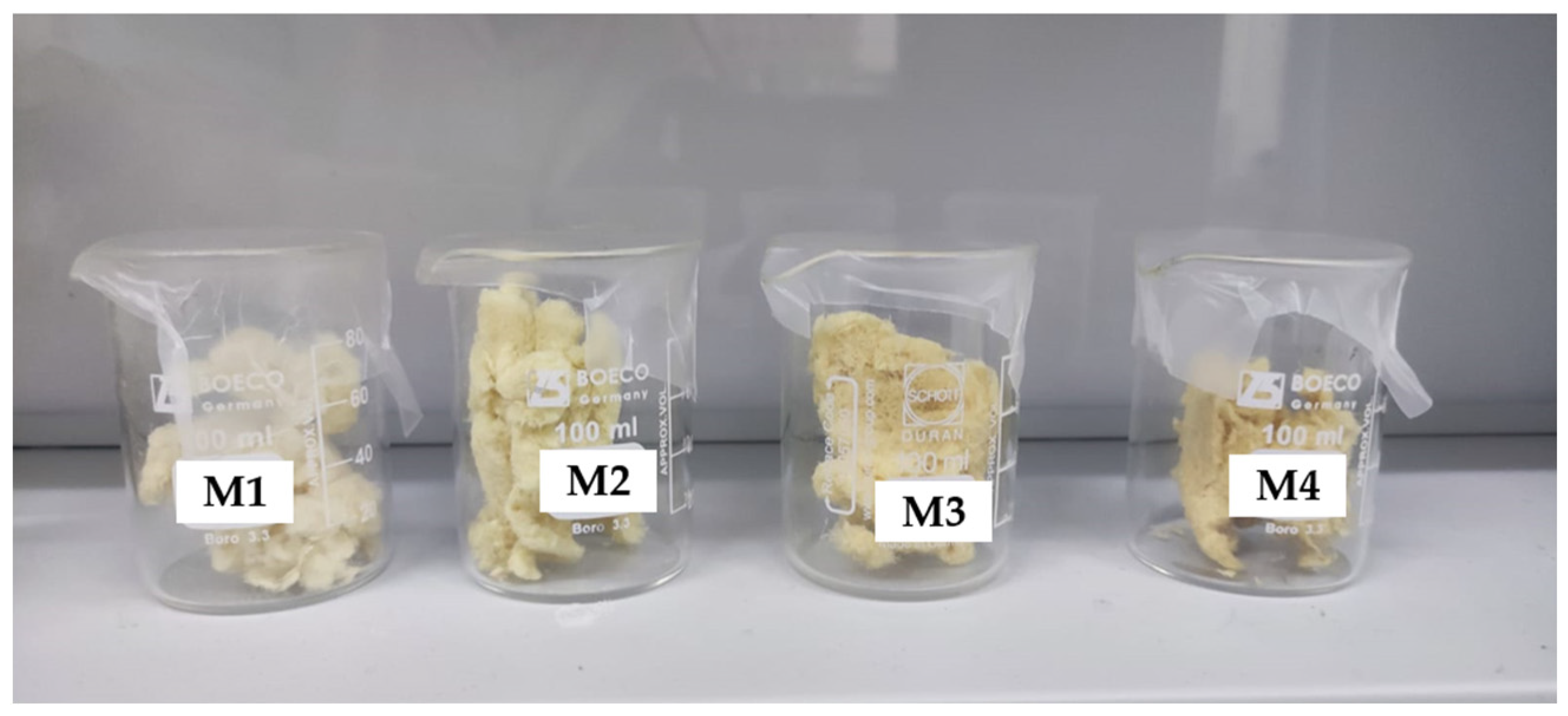

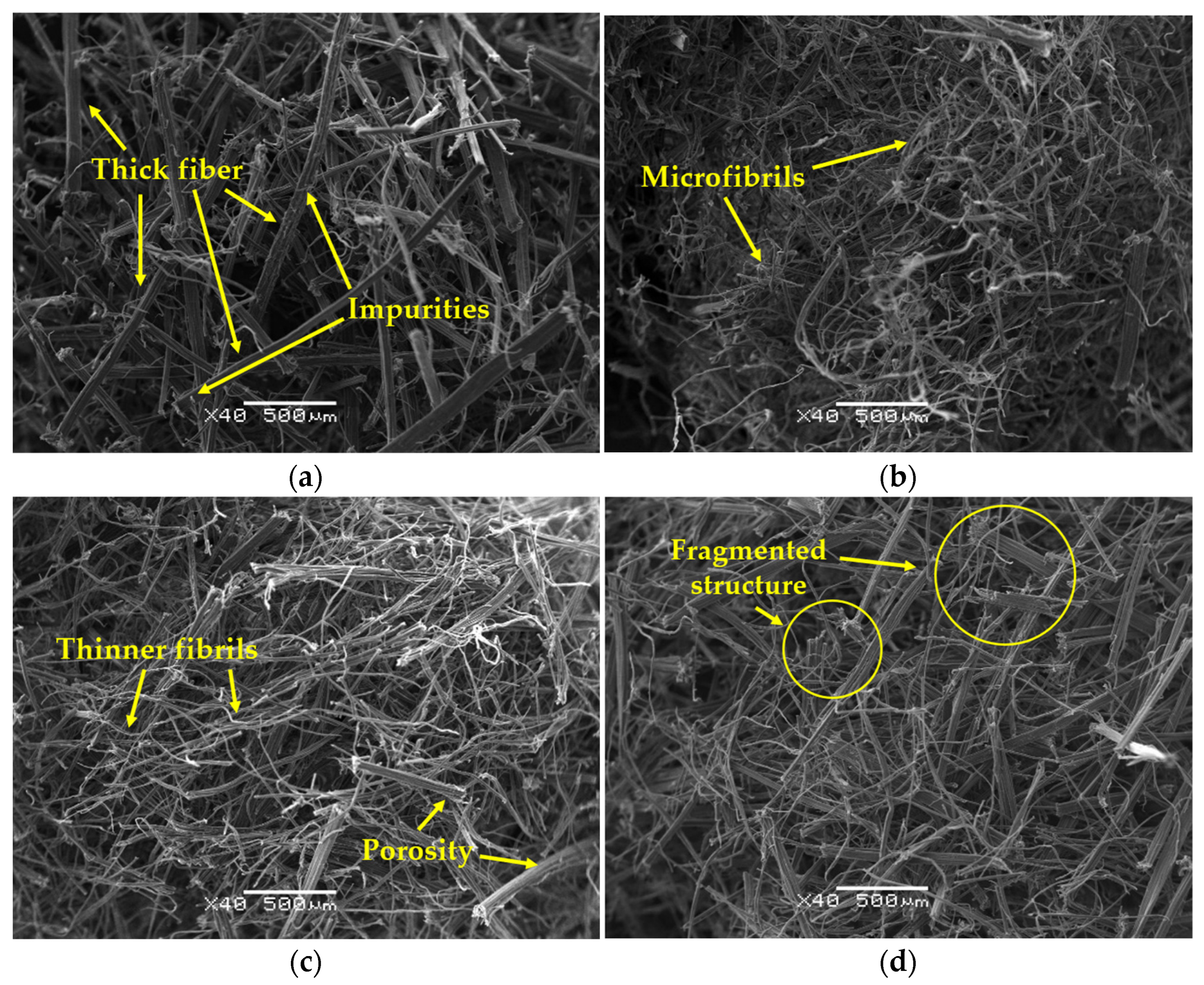
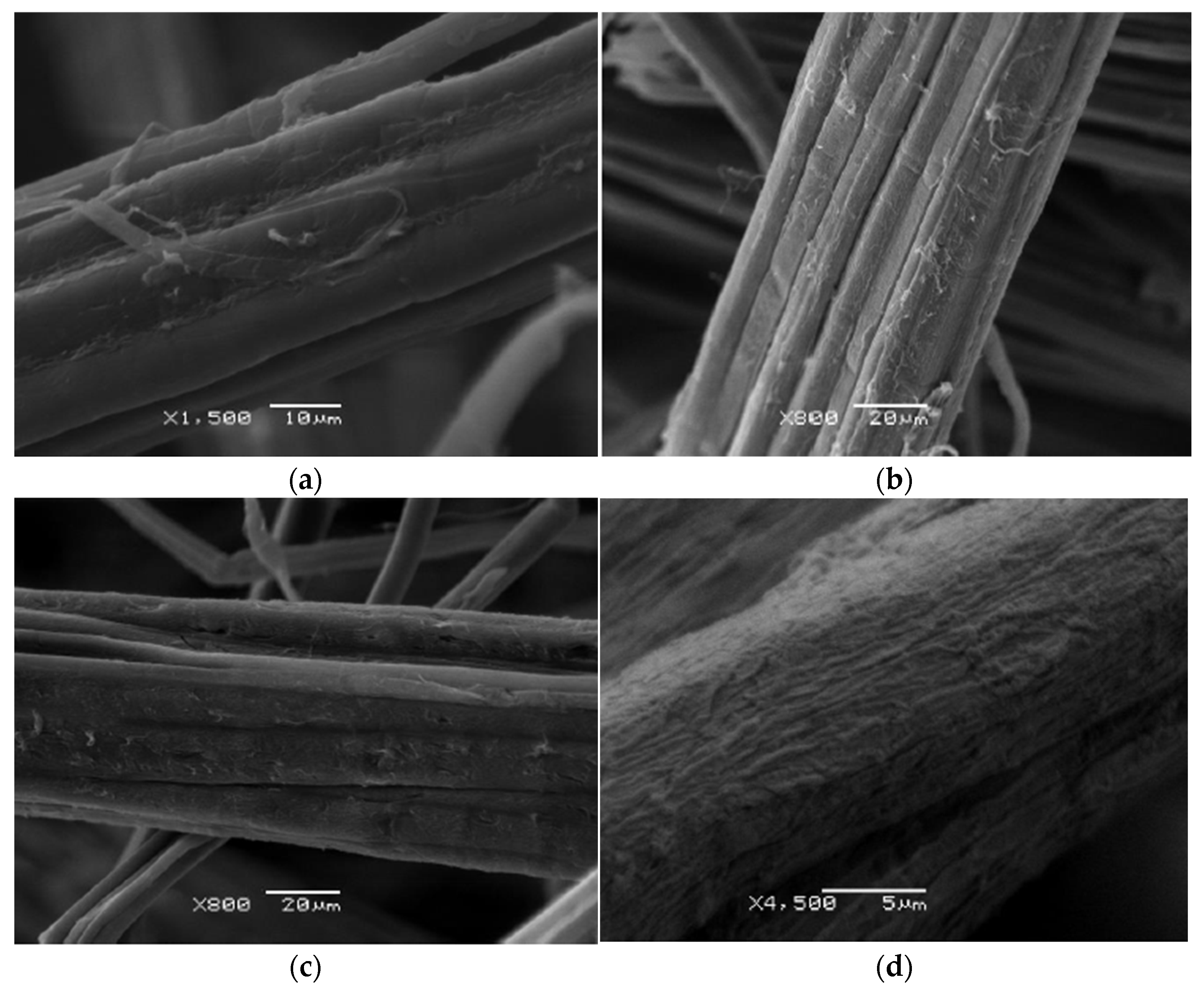
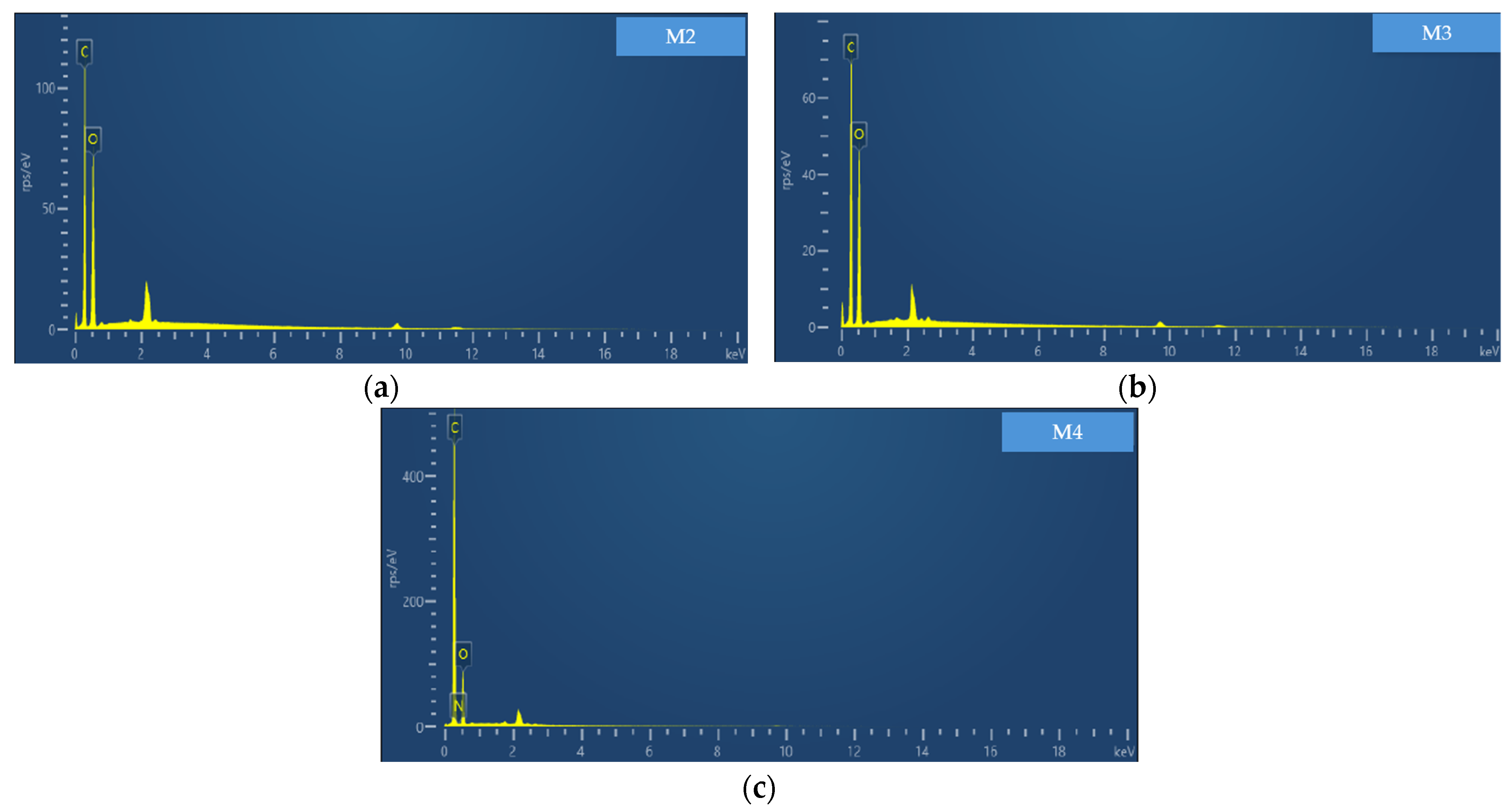
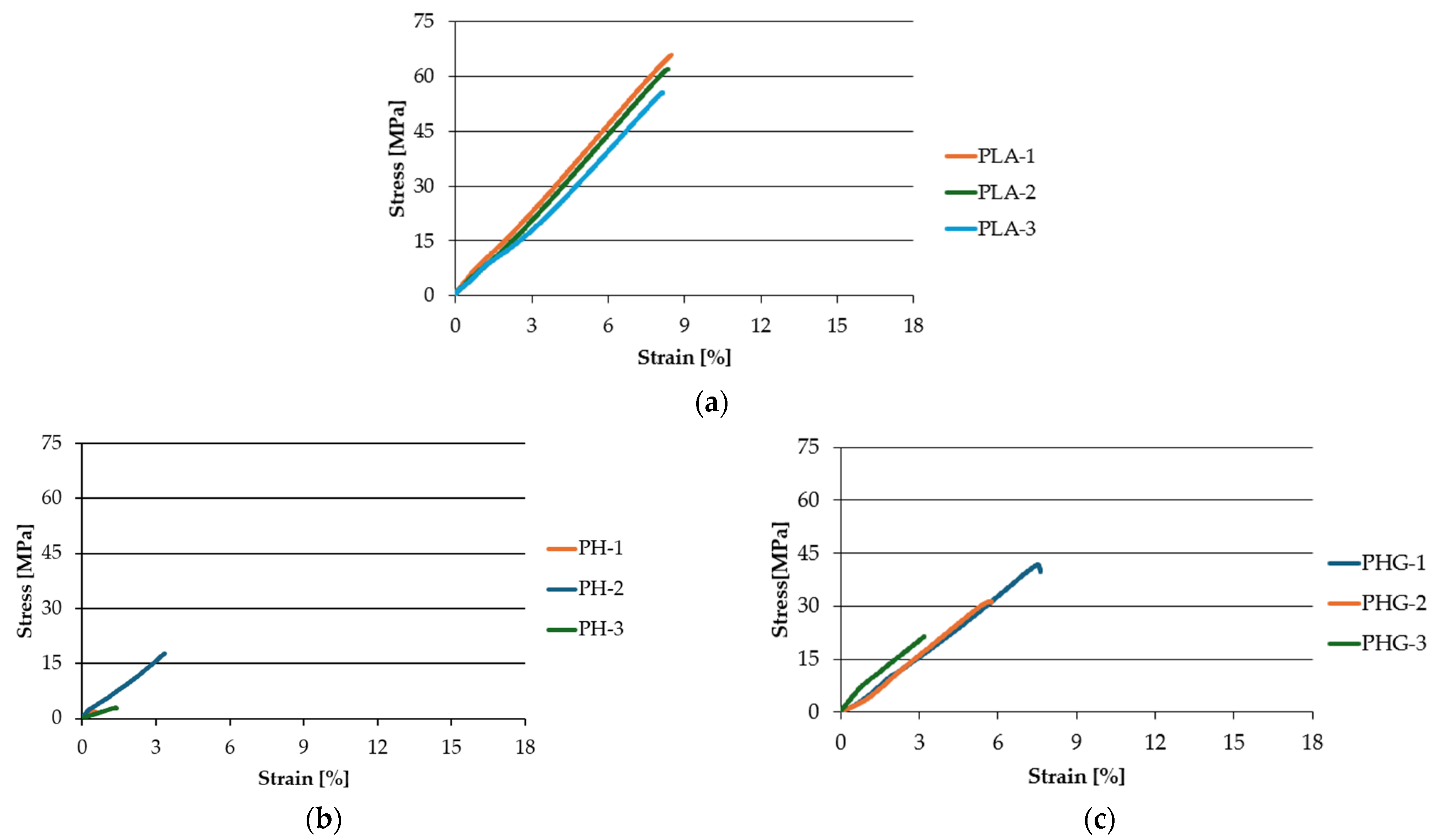

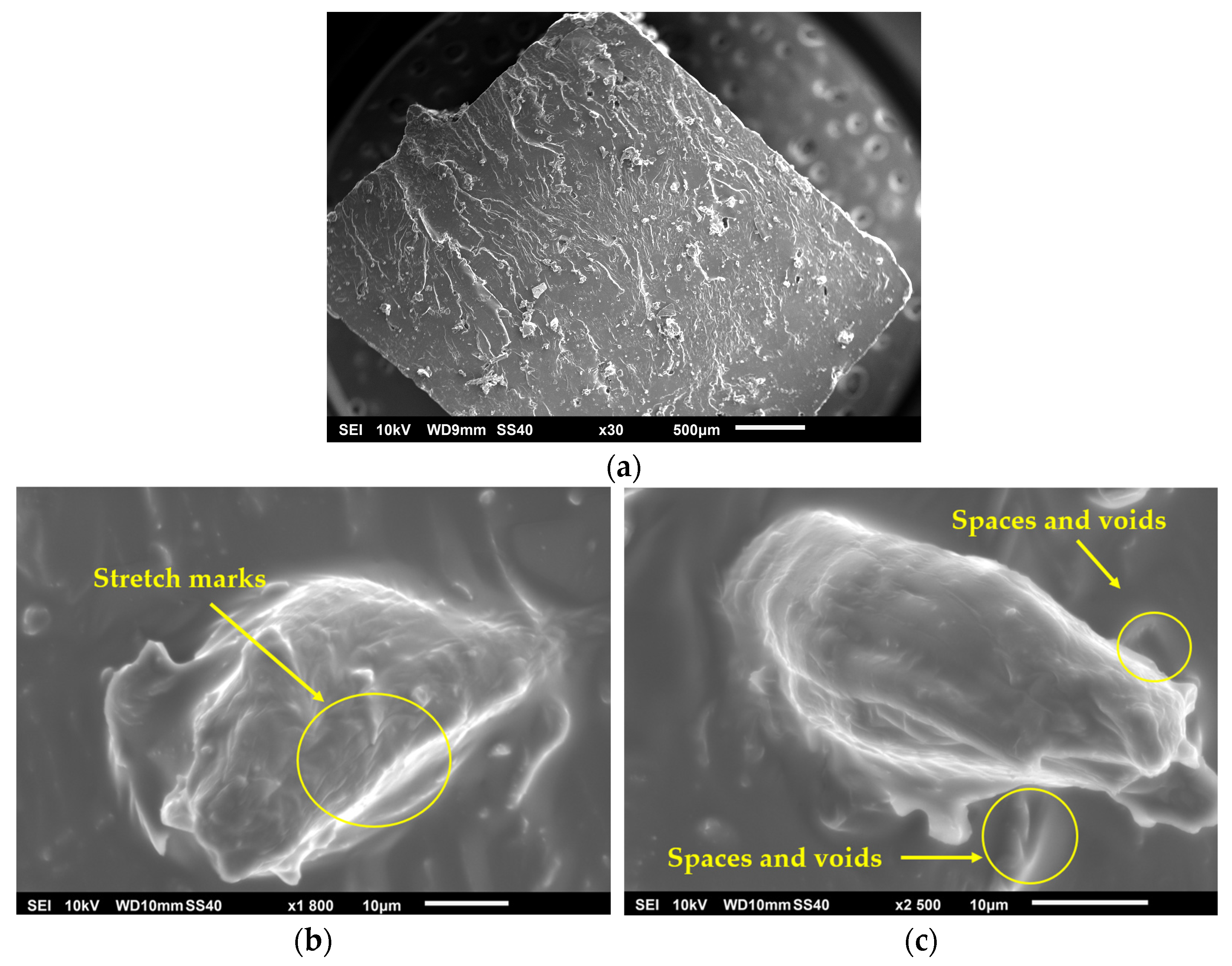
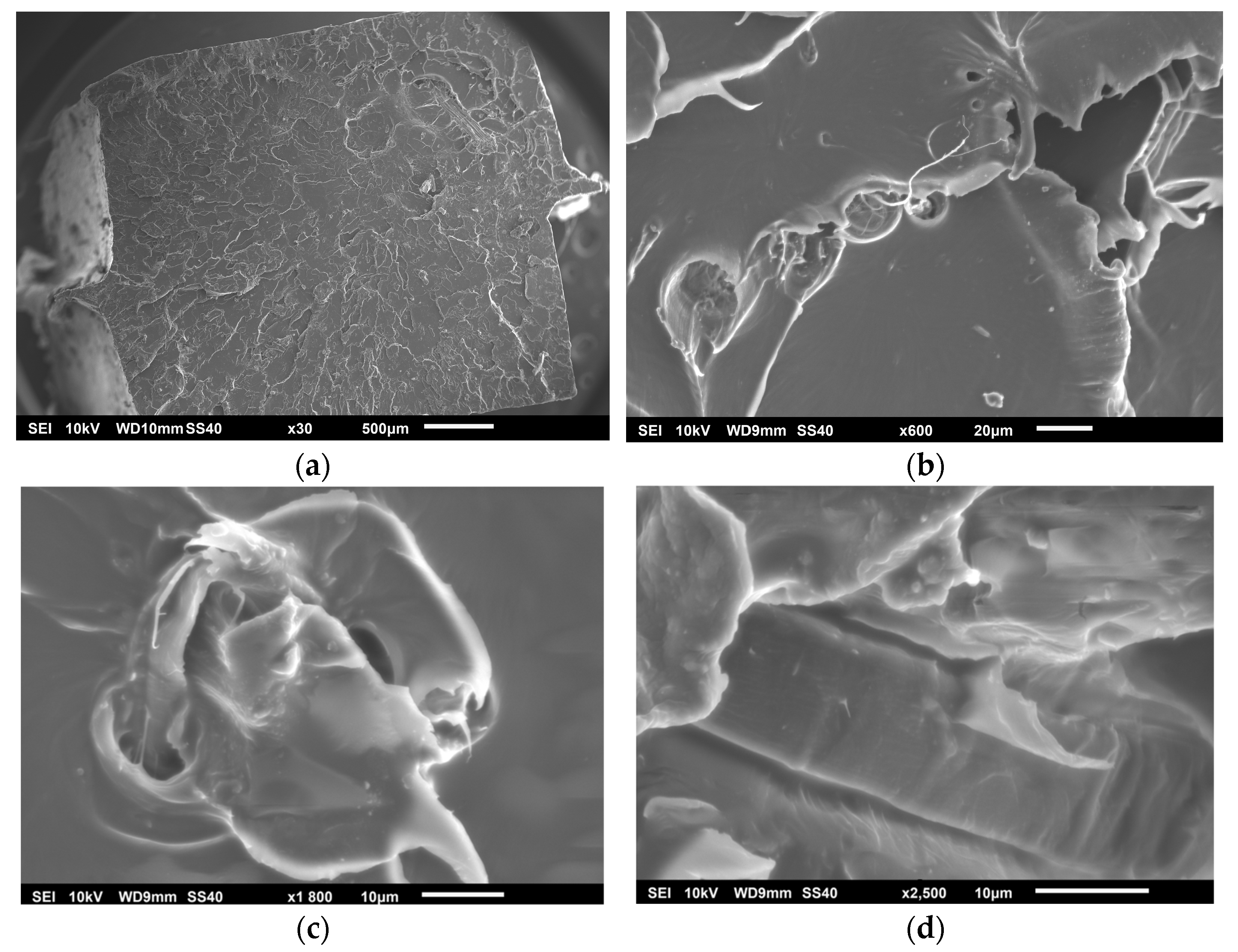
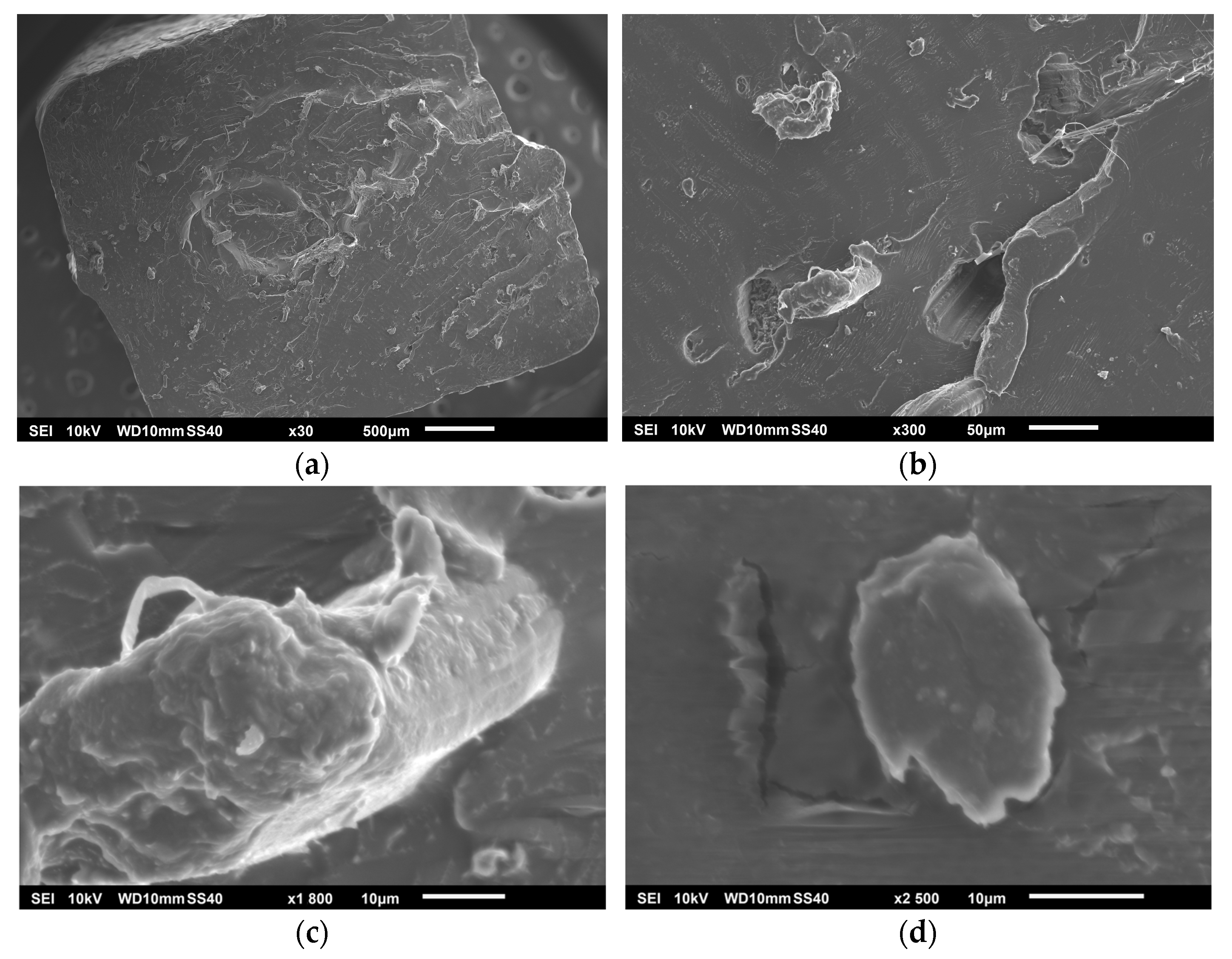
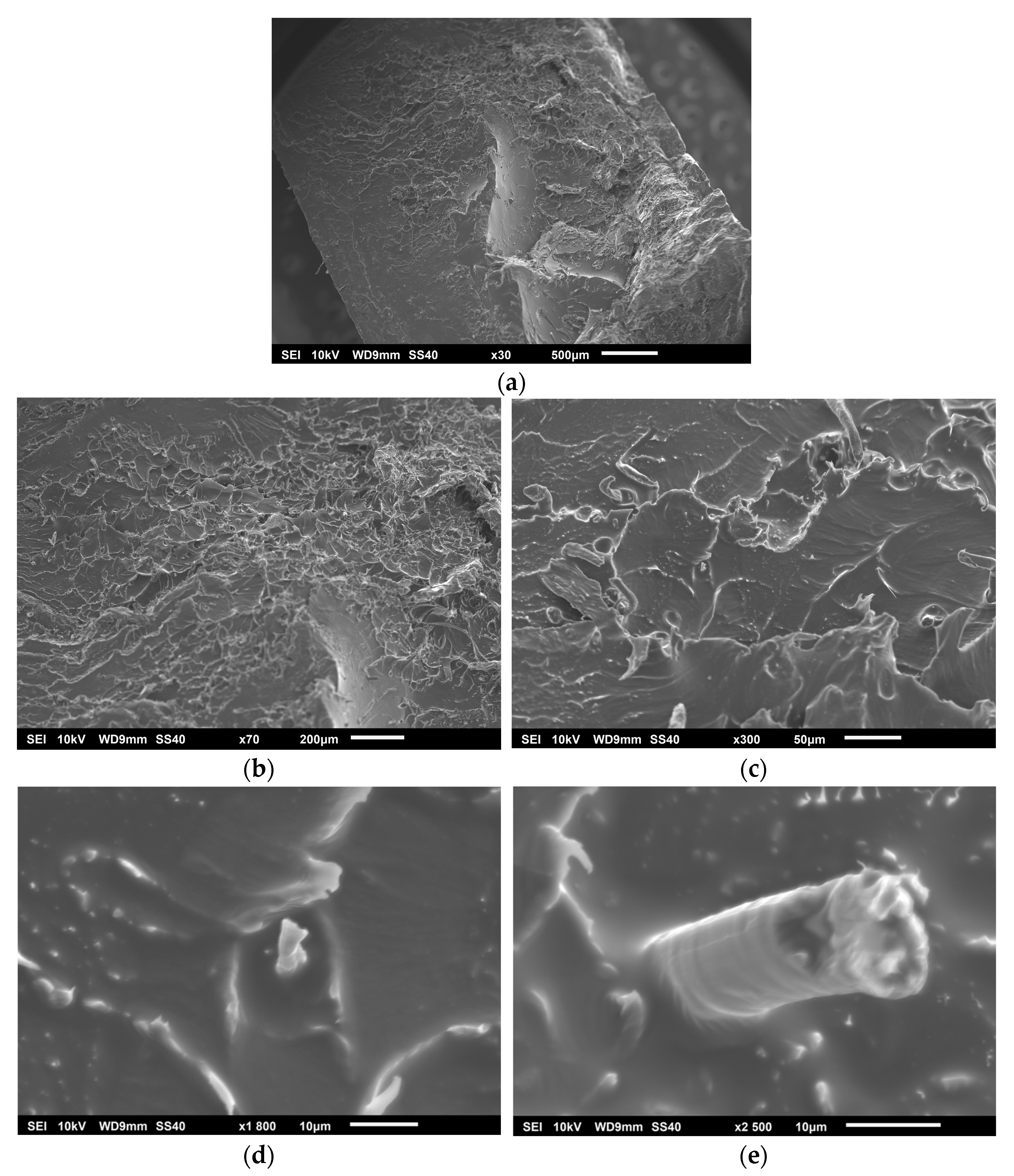
| Specimen | Conditions | Hemp (g) | NaOH (g) | Water (mL) | EPTA (mL) |
|---|---|---|---|---|---|
| M1 | 65 °C and 1500 rpm | 1 | 2.5 | 47.5 | 1.66 |
| M2 | 65 °C and 1500 rpm | 1 | 2.5 | 47.5 | 4.17 |
| M3 | 65 °C and 1500 rpm | 1 | 2.5 | 47.5 | 8.34 |
| M4 | 90 °C and 1500 rpm | 1 | 2.5 | 47.5 | 8.34 |
| Specimen | PLA (%) | Hemp (%) | GMA (mL) | EPTA (mL) | Glycerin (mL) |
|---|---|---|---|---|---|
| PLA | 100 | 0 | 0 | 0 | 0 |
| PH | 95 | 5 | 0 | 0 | 4 |
| PHG | 95 | 5 | 4 | 0 | 0 |
| PHE90 | 95 | 5 | 0 | 8.34 | 4 |
| PHGE90 | 95 | 5 | 4 | 8.34 | 0 |
| M2 | M3 | M4 | |||||||
|---|---|---|---|---|---|---|---|---|---|
| Element | % Weight | Sigma % Weight | % Atomic | % Weight | Sigma % Weight | % Atomic | % Weight | Sigma % Weight | % Atomic |
| C | 51.55 | 0.13 | 58.63 | 51.44 | 0.14 | 58.52 | 78.81 | 0.59 | 83.10 |
| O | 48.45 | 0.13 | 41.37 | 48.56 | 0.14 | 41.48 | 20.12 | 0.24 | 15.93 |
| N | - | - | - | - | - | - | 1.07 | 0.70 | 0.97 |
| Total | 100.00 | - | 100.00 | 100.00 | - | 100.00 | 100.00 | - | 100.00 |
| Specimen | N° | σt [MPa] | σt average [MPa] | ε [%] | εaverage [%] | Eaverage [MPa] |
|---|---|---|---|---|---|---|
| PLA | 1 | 65.78 | 8.50 | |||
| 2 | 61.98 | 61.05 | 8.35 | 8.32 | 7.33 | |
| 3 | 55.38 | 8.12 | ||||
| PH | 1 | 1.80 | 0.48 | |||
| 2 | 17.73 | 7.47 | 3.35 | 1.73 | 4.32 | |
| 3 | 2.89 | 1.35 | ||||
| PHG | 1 | 41.70 | 7.51 | |||
| 2 | 31.39 | 31.49 | 5.71 | 5.47 | 5.75 | |
| 3 | 21.37 | 3.19 | ||||
| PHE90 | 1 | 57.17 | 16.18 | |||
| 2 | 53.88 | 53.40 | 11.67 | 11.77 | 4.54 | |
| 3 | 49.16 | 7.45 | ||||
| PHGE90 | 1 | 60.27 | 10.25 | |||
| 2 | 52.18 | 56.78 | 8.45 | 9.11 | 6.23 | |
| 3 | 57.89 | 6.64 |
Disclaimer/Publisher’s Note: The statements, opinions and data contained in all publications are solely those of the individual author(s) and contributor(s) and not of MDPI and/or the editor(s). MDPI and/or the editor(s) disclaim responsibility for any injury to people or property resulting from any ideas, methods, instructions or products referred to in the content. |
© 2025 by the authors. Licensee MDPI, Basel, Switzerland. This article is an open access article distributed under the terms and conditions of the Creative Commons Attribution (CC BY) license (https://creativecommons.org/licenses/by/4.0/).
Share and Cite
Valin Fernández, M.; Monsalves Rodríguez, M.A.; Medina Muñoz, C.A.; Palacio, D.A.; Soto, A.G.O.; Valin Rivera, J.L.; Valenzuela Diaz, F.R. Cationized Hemp Fiber to Improve the Interfacial Adhesion in PLA Composite. Polymers 2025, 17, 652. https://doi.org/10.3390/polym17050652
Valin Fernández M, Monsalves Rodríguez MA, Medina Muñoz CA, Palacio DA, Soto AGO, Valin Rivera JL, Valenzuela Diaz FR. Cationized Hemp Fiber to Improve the Interfacial Adhesion in PLA Composite. Polymers. 2025; 17(5):652. https://doi.org/10.3390/polym17050652
Chicago/Turabian StyleValin Fernández, Meylí, Matías Angelo Monsalves Rodríguez, Carlos Andrés Medina Muñoz, Daniel A. Palacio, Angelo Giovanni Oñate Soto, José Luis Valin Rivera, and Francisco Rolando Valenzuela Diaz. 2025. "Cationized Hemp Fiber to Improve the Interfacial Adhesion in PLA Composite" Polymers 17, no. 5: 652. https://doi.org/10.3390/polym17050652
APA StyleValin Fernández, M., Monsalves Rodríguez, M. A., Medina Muñoz, C. A., Palacio, D. A., Soto, A. G. O., Valin Rivera, J. L., & Valenzuela Diaz, F. R. (2025). Cationized Hemp Fiber to Improve the Interfacial Adhesion in PLA Composite. Polymers, 17(5), 652. https://doi.org/10.3390/polym17050652










